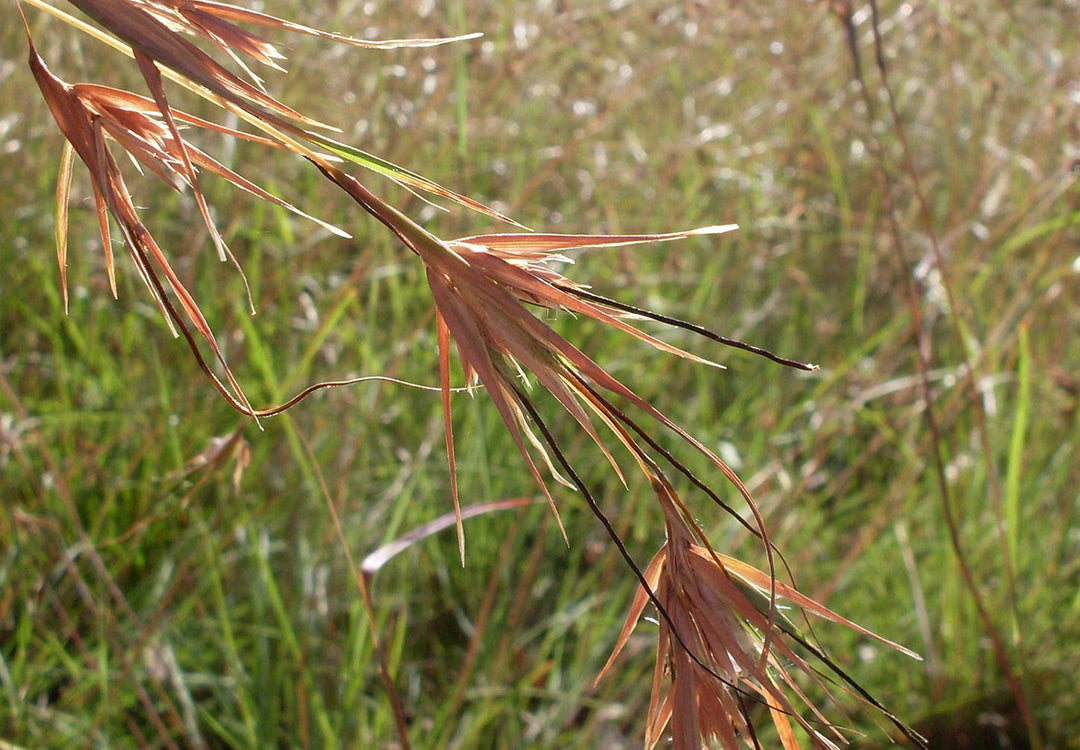
Grasses are an easily identified family of wind-pollinated monocots that are especially good at playing the role of ground cover.
Some are annual and some are perennial. Some varieties may go dormant or die off during the hotter or colder months of the year, whereas others will hold their soil year-round.
Description
Grasses come in two types: clumping and running. Clumping grasses stay in on spot and rely on seeds alone to spread, whereas spreading grasses use seed as well as runners (a.k.a. stolons, or overground stems) and rhizomes (underground stems) to spread.
They have distinct nodes and internodes with sheathed leaves, making them quite easy to identify, even when they aren’t in flower.
Bisexual flowers are always in an inflorescence, sometimes with pedicels (called a raceme), sometimes sessile (called a spike), and sometimes in a panicle form which is a compound inflorescence with lateral branching. Individual flowers are usually too small to see without a magnifying glass.
If you do get a close look at a grass flower, you’ll notice it’s lacking in sepals and petals and this is because they have no need to attract pollinators. Instead, they allow the wind to carry their pollen, much like their gymnosperm ancestors did.
Flowers, Fruits & Leaves
Sepals:
None
Petals:
None. Modified leaves called bracts appear like petals or sepals, and become the “chaff” that is discarded in agriculture.
Male:
Usually 3 stamens are present, sometimes 2 or 6.
Female: 3 united carpels form 1 chamber and 1 grain.
Grain: The grass seed-containing fruit is called a grain which is revealed by removing the chaff of mature fruits. Some species drop their grains, whereas others hold onto them.
Leaves: Alternate with sheathing and parallel venation, including one thicker mid vein.
Noteworthy Types
All grains belong to the grass family including wheat, corn, oats, rye, barley, rice and the list goes on. Quinoa and buckwheat are not true members of the grass family.

Dry wheat Triticum sp. crop. Image source
Couch grass can be a colloquial name for multiple genera of running grasses. One couch Cynodon dactylon is one of the main species that has cultivars (such as blue couch and green couch) used in Aussie lawns. It may be known elsewhere in on of its forms as bermuda grass or crab grass.
There is a couch grass that is treated as a weed in the UK and US called Elymus repens that is not especially closely related to the couch we know here in Australia.

Couch grass Stenotaphrum secundatum flowers. Image source
Buffalo grass is a common name for multiple running species including Bouteloua dactyloides and varieties in the Stenotaphrum genus like Sir Walter, which is a cultivar of S. secundatum.

A Sir Walter Stenotaphrum secundatum lawn with signature purple flower spikes. Image source
Kikuyu Cenchrus clandestinum is an eastern African running grass that does well in moderately colder regions and is reasonably drought-tolerant.

A kikuyu Cenchrus clandestinus stalk with alternately sheathed leaves. Image source
Kangaroo grass is a clumping grass with distinctive earthy red flower spikelets. There are often considered two species: one native to Asia and Africa, Themeda triandra, and one native to Australia, Themeda australis though they’re both naturalised in Australia and are so similar that they’re sometimes both classed as a single species, T. triandra.

Kangaroo grass (in this case Themeda australis) with its distinctive flower spikelets. Image source
True bamboos are in a subfamily called Bambusoideae, with most members tending to originate in warmer areas. They generally flower seldomly, though once they do they tend to die.
Phyllostachys aurea is an example of an ornamental running bamboo that is actually incredibly invasive throughout the world, including Australia and elsewhere. Once it takes hold, it can ruin structures and even heavy digging machinery usually fails to completely erradicate the pest.

Phyllostachys aurea bamboo running along a California roadside. Image source
Conclusion
Grasses have pretty much taken over the world, with varieties thriving in almost any conceivable environment. Notice the differences between them and other plants that can be considered look-a-likes such as asparagus and lily family members (which don’t really look like grasses at all once you look a bit closer).
If you haven’t already read my articles on plant identification and scientific names, I recommend reading those to get a broader picture of the topic. Alternatively, you can browse some of my other plant families, subfamilies and genera below.
